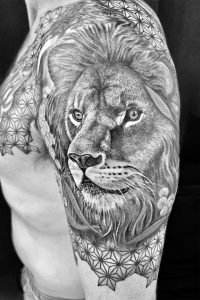Understanding the art of realism tattoos
Realism tattoos represent a sophisticated branch of body art that focuses on creating lifelike images. This intricate form of tattooing requires not only exceptional skills but also a deep understanding of shading, anatomy, and colour theory. Throughout history, realism has evolved from shared cultural expressions to a distinctive art form, cherished for its beauty and complexity.
What is a realism tattoo?
A realism tattoo is designed to replicate a real-world image or scene, making it appear as though it is a photograph or a painted masterpiece on the skin. The aim is to capture details such as light, shadow, and texture, often portraying portraits, animals, or lifelike representations of objects. This technique requires meticulous attention to detail and the ability to convey depth and dimension in a tattoo.
Many artists employ advanced techniques, including layering and blending pigments, to achieve a three-dimensional look. The emotional impact of such tattoos is often profound, as they can represent deeply personal meanings for the wearer, from memorialising loved ones to expressing one’s passions and interests. The choice of subject matter can vary widely, with some individuals opting for intricate floral designs that reflect personal milestones, while others may choose iconic figures that resonate with their life experiences.
The history and evolution of realism tattoos
The roots of realism tattoos can be traced back to the early 20th century when artists began to experiment with creating tattoos that resembled actual images. Over time, advancements in tattoo technology, including needles and inks, have facilitated the development of more complex designs. Notably, artists such as Paul Booth and Kat Von D have played pivotal roles in popularising the realism style in contemporary tattooing.
As the awareness and acceptance of tattoos grew, so did the demand for high-quality realism work. Today, realism tattoos are celebrated for their technical prowess, and many tattoo conventions host competitions to showcase the finest works in this genre. The evolution of realism continues as artists push boundaries, striving to achieve even greater levels of authenticity in their designs. This ongoing journey has led to the incorporation of various styles and influences, merging realism with elements of surrealism or abstract art, creating unique hybrids that challenge traditional perceptions of body art. Furthermore, the rise of social media platforms has allowed artists to share their work with a global audience, fostering a vibrant community where techniques and inspirations are exchanged, thus enriching the art form even further.
The process of getting a lifelike tattoo
Getting a realism tattoo is a multifaceted journey that involves much more than merely stepping into the studio and choosing a design. When looking to get a tattoo in Sydney, It is crucial for individuals to fully understand the process to ensure a successful experience and a tattoo that meets their expectations.
Initial consultation and design
The first step in obtaining a lifelike tattoo is an initial consultation with the tattoo artist. During this meeting, it is essential to discuss your vision, including preferred styles, themes, and personal significance of the tattoo. Artists often encourage clients to bring reference images that inspire them.
This phase is not just about the design; it is also an opportunity for the artist to evaluate the feasibility of the desired work and to provide guidance on sizing and placement. A good tattoo artist will offer insights that can enhance the final outcome, ensuring that the design flows with the body’s contours and complements the client’s lifestyle. Additionally, this initial discussion allows for an exploration of colour palettes and shading techniques that can bring the artwork to life, as well as considerations for how the tattoo may age over time. Understanding these elements can significantly influence the longevity and vibrancy of the tattoo.
The tattooing process explained
Once the design is finalised, the tattooing process can commence. This stage may take several hours, depending on the complexity and size of the artwork. The artist will begin by outlining the design before applying shading and colour, which can require multiple sessions.
During the tattooing process, pain levels can vary; however, many clients find that the adrenaline and excitement of seeing their design come to life help to manage any discomfort. Professional artists focus on creating a comfortable environment, making frequent breaks to ensure the client remains at ease throughout the procedure. Moreover, many studios now offer numbing creams or other pain management options to help alleviate discomfort, making the experience more enjoyable. It’s also worth noting that aftercare is a critical part of the process; artists will provide detailed instructions on how to care for the fresh tattoo, which is vital for ensuring that the colours remain vibrant and the lines crisp, ultimately preserving the lifelike quality of the artwork for years to come.
Choosing the right realism tattoo artist in Sydney
Finding the perfect tattoo artist is paramount to achieving the desired outcome for a realism tattoo. With many of the best tattoo artists in Sydney, it’s crucial to conduct thorough research before making a decision.
What to look for in a tattoo artist
When searching for a realism tattoo artist, look for someone with extensive experience in the realism style. Review their portfolio carefully to assess the quality and detail of their previous work. Pay particular attention to their shading techniques and the lifelike quality of their tattoos.
Additionally, consider their hygiene practices and the overall atmosphere of the studio. A clean, professional environment is essential for ensuring a safe tattooing experience, as contamination can lead to infections or complications.
Questions to ask your potential tattoo artist
Before committing to a tattoo artist, engage them in conversation to gauge their expertise. Ask about their training, experience with realism tattoos, and their creative process. It’s also wise to inquire about their approach to aftercare and how they support clients through the healing process.
By asking these questions, you not only ensure that you are well-informed about the artist’s qualifications but also establish a rapport that can lead to a smoother tattooing experience. A good artist will appreciate your diligence and will be more than happy to share their insights.
Aftercare for your realism tattoo
Proper aftercare is crucial for maintaining the integrity and vibrancy of your realism tattoo. Neglecting aftercare can lead to fading or infection, significantly diminishing the tattoo’s quality over time.

Immediate aftercare tips
Immediately following the tattooing session, your artist will provide specific aftercare instructions, which typically include keeping the area clean and avoiding exposure to direct sunlight or soaking in water. It is advisable to leave the bandage on for the recommended duration, allowing the skin to begin its healing process without disruption.
During the first few days, it is essential to gently wash the tattoo with mild soap and water, applying a thin layer of a recommended ointment. Avoid picking at scabs, as this can lead to scarring and compromise the design.
Long-term care for your tattoo
Long-term care of your realism tattoo involves moisturising the area regularly and continuing to protect it from the sun’s harmful rays. Using a broad-spectrum sunscreen can help prevent colour fading and ensure that the details remain crisp and clear.
In addition, staying hydrated and maintaining overall skin health will significantly enhance the longevity of your tattoo. Engaging in regular skin routine practices will also contribute to keeping your tattoo looking its best for years to come.
The impact of a realism tattoo
Realism tattoos can have a profound impact on an individual, both personally and socially. They often serve as expressive forms of identity, making significant statements about the wearer’s beliefs, values, and experiences.
The personal significance of tattoos
For many, realism tattoos carry substantial personal significance. They may be dedicated to loved ones, commemorate important life events, or represent personal interests and passions. Such tattoos can act as reminders of cherished memories or milestones, deeply embedding their meanings into the wearer’s life.
As a form of self-expression, these tattoos allow individuals to showcase their narratives and stories visually, forging a connection between their exterior and internal worlds. The process of choosing a design often fosters self-reflection, resulting in a meaningful representation of one’s journey.
The societal perception of tattoos
Over the years, societal perceptions of tattoos have shifted dramatically. While tattoos were once associated with rebellion or subculture, they are now widely accepted and embraced within mainstream culture. Realism tattoos, in particular, are recognised for their artistic value and are often seen as a legitimate form of fine art.
This changing landscape has led to an increase in the number of tattoo enthusiasts, with many individuals proudly sharing their body art online. As the stigma surrounding tattooing continues to diminish, the appreciation for the craftsmanship and skill required to create realism tattoos is increasingly recognised and celebrated.
